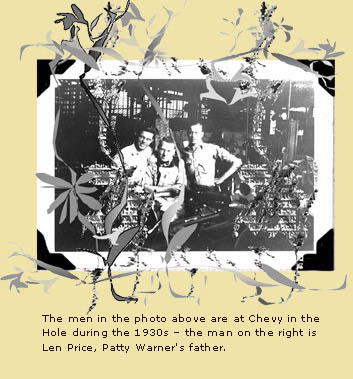![]()
Forty Years Later with two Old Testament Dudes
On Dewey Whitwell's Knee, I Consider My Second Amendment Rights
![]()

"Jan Worth published her great novel Nightblind herself (with iUniverse) and thank goodness she did. She worked on it for about thirty years she says in the Acknowledgements.
Worth’s book is splendid and delightful, wise and witty and rich. Twenty times better, say, than something like Eat, Pray, Love...." (Read the full review...)
![]()

Essays > On GM's 100th Birthday, A Ghostly Weediness at Chevy in the Hole

After 100 years, the acreage along the Flint River where General Motors launched its manufacturing operations in 1908 has long been stripped of its factories. It sits as quietly as a cemetery in the breezes of a Midwestern summer evening.
Chevy in the Hole, as we all know it, is irresistibly ghostly and haunting. Yet there’s something else stirring among the cracked foundations and oil dumps left behind.
I love that inelegant name, assigned -- affectionately, I like to think -- by the three or four generations of “shop rats” who worked in that bottomland where the river curves.
A couple of weeks ago, I took a half-dozen graduate students in a spring writing class called “Green Ink” on a bike tour of the 130-acre site.
Increasingly, it seems right not to drive a car when paying tribute to the fallen behemoths, especially on this summer of the GM centennial. It hurts to think about the big old gas guzzlers of the boom years – their day long past, the all-American enthusiasm behind those gorgeous cars now a troubling anachronism.
We all know the love is gone. Now we’re slowly giving up the dream.
The Delphi Corporation, once known as AC Spark Plug, owns most of Chevy in the Hole now, with the Genesee County Land Bank holding title to a few plots that used to be parking lots.
A plan has been proposed to make it part of Flint’s renewal. This is good: there are booklets, maps, shiny smart young people involved, people who were never victims of the old failed marriage.
Pausing to catch our breath on Bluff Street overlooking the site, my students and I didn't have much to say as we took in the concretized channel of the river and the silent expanse where some of the fights of the 1936 Sit Down Strike took place and where millions of car parts were banged out on noisy and oily assembly lines.
Several mallards noodled along in the brown water. A red-winged blackbird sailed by. A remarkable single cottonwood did its leafy hula. In the middle of downtown, it’s so still there.
Chevy in the Hole is officially called a brownfield now – a term, according to the Land Bank, for a site where “real or perceived contamination complicates redevelopment.”
One of my friends remembers his “shop rat” dad describing how when machinery leaked oil there, they’d simply drill a hole and let the muck drain straight into the soil. Most people believe that land is pretty battered.
But the brownfields of Chevy in the Hole are not really brown. Many green things grow in the cracks and edges. I asked our tour guide, Christina Kelly of the Land Bank, what they were. "Just weeds," she said.
When I reported this to my biology professor friend Tracy Wacker, she said, with her usual bracing candor, "The definition of a weed is a plant growing where somebody doesn't want it to. Looked at that way, none of the plants at Chevy in the Hole are weeds, because nobody cares if they grow there."
I knew I wanted to go back again. The place put some kind of spell on me.
So one hot day, in the midst of a light rain that soon gave way to muggy sun, Tracy and I walked three blocks from Saginaw Street down Kearsley, scrambled around a chain-link fence and poked around in the humid overgrowth on the cracked concrete and the river bank.
She called out the names of least 30 different species: rumex, chicory, bachelor's button, black nightshade, common mullein, curlydock, dogwood, catalpa, coreopsis, lanceleaf plantain, milkweed, dames rocket, buckthorn, bull-thistle, crown vetch.
Also multiflora rose, mulberry, lamb’s quarters, catnip, moneywort, butter and eggs, goatsbeard, hawkweed, evening primrose, yellow clover, Deptford pink, honeysuckle, Virginia creeper, dipsica thistle, buttercup, late meadow rue, goldenrod and ox-eye daisy.
One of the most prolific species butting into the ruins is a devilish compound-leafed interloper named, ironically,Tree of Heaven. It is everywhere. It stinks.
That’s because it contains compounds that keep other plants from growing. Its deep and feisty underground runners make it almost possible to kill -- cut it down, it comes up two feet away.
Obviously, as Tracy pointed out, many if not most of the species in the brownfield are invasive and should not be crowding the riverbank. They are there because they thrive in meager soil. They are opportunists.
The metaphor that comes to mind here is tempting but a tiresome one for Flint itself. I want a new metaphor for our town – something that doesn’t make us sound like we just got out of the penitentiary.
Anyway, if and when the site rebounds, a more natural riparian ecosystem might return. But even Tracy saw a certain austere beauty to the brownfield.
Popping up amid the invaders, there are small and hopeful willows, that yellow coreopsis -- a native -- and that dogwood.
On GM’s 100th birthday, the graveyard of Flint’s deadbeat dad is recycling itself -- quiet, slow, fascinating. Almost anywhere you look, there's something to notice. In the persistent weediness, there’s a whisper of history receding, a hint of something lusty and green coming back in its place.



















